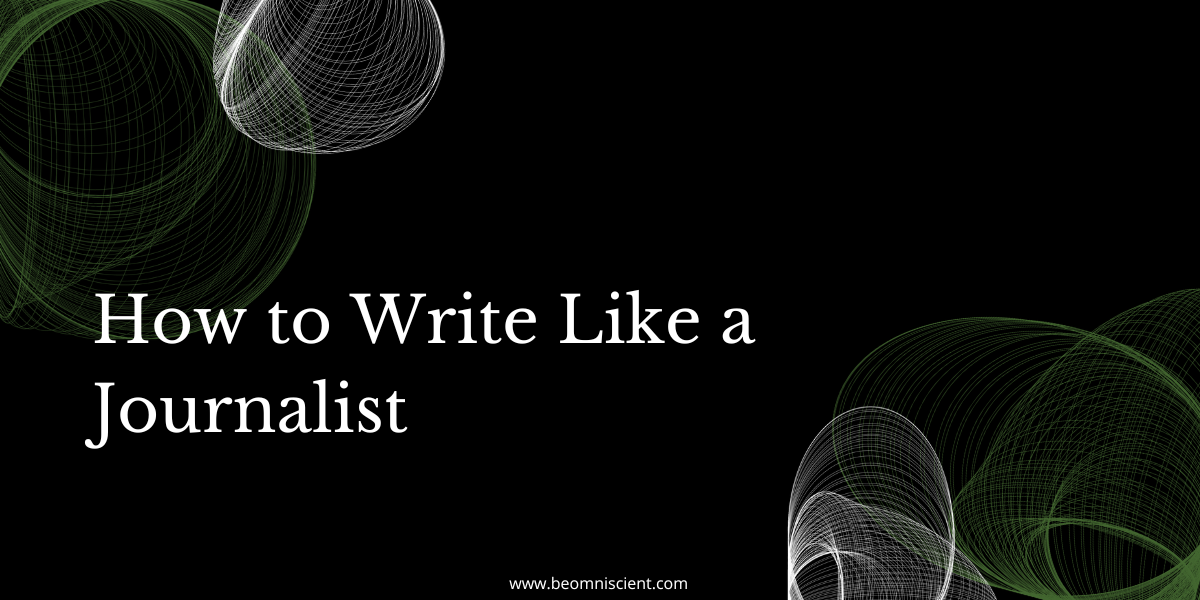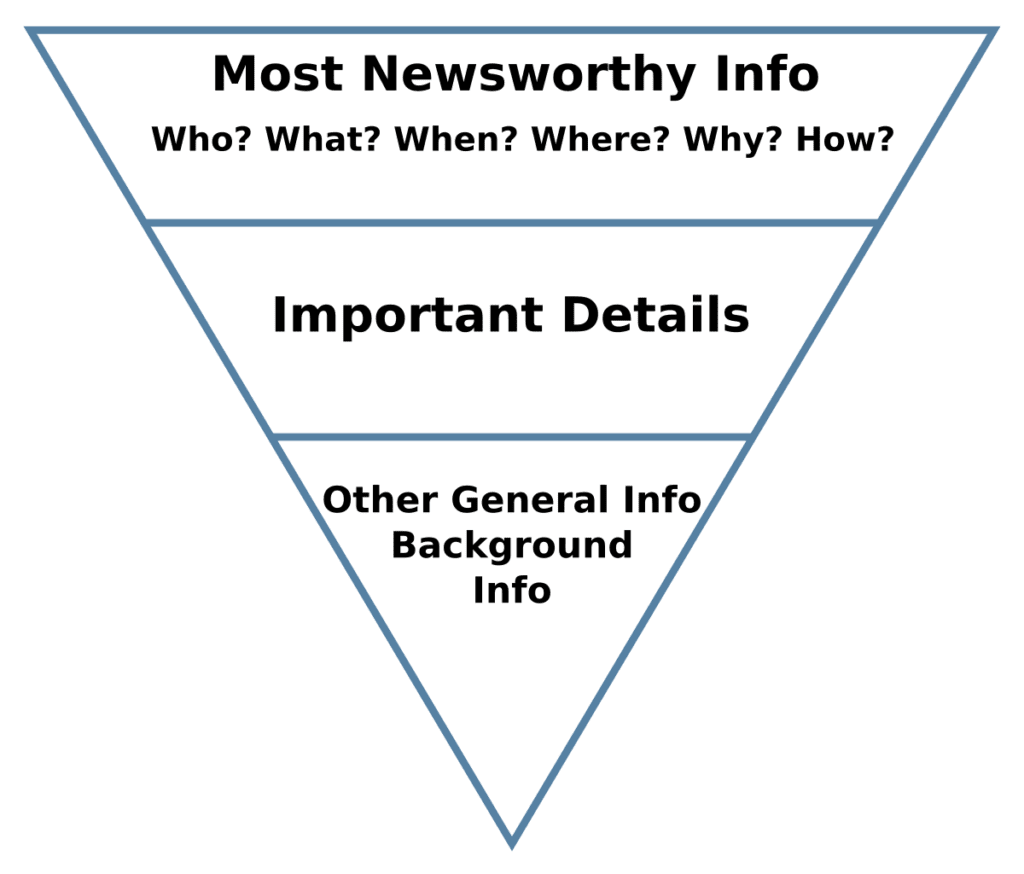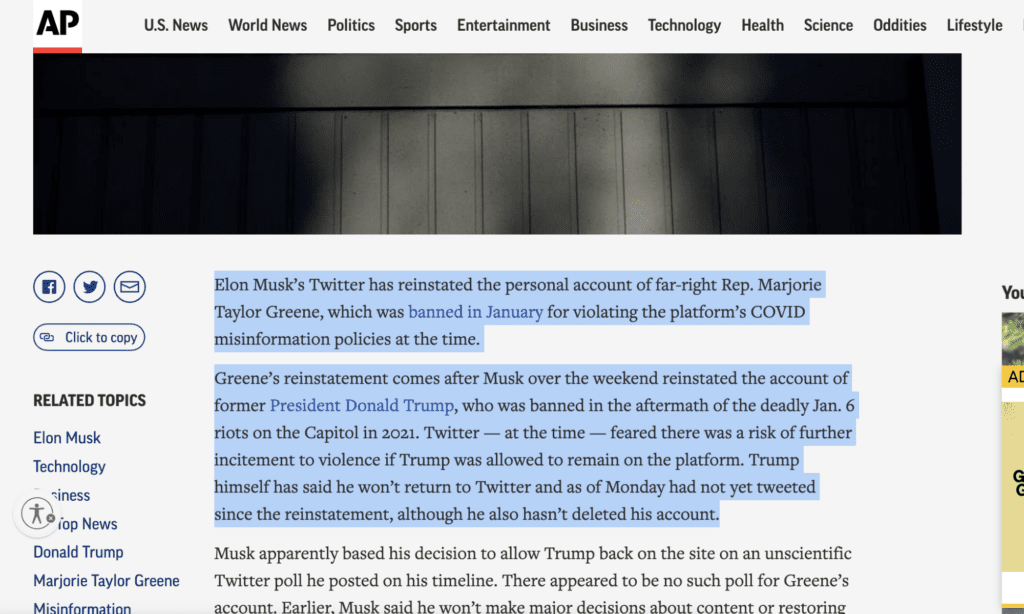
Writing like a journalist is all the rage in the content marketing and SEO space.
As a University of Wisconsin Journalism school graduate, I can tell you most people have no idea what they’re talking about when they say this.
There are many types of journalists. Not all forms of journalism are great or even adequate for modern forms of content marketing. In fact, journalists have taken tons of cues from content marketers, SEOs, and social media marketers in recent years.
In any case, there are definitely lessons you can learn about writing clearly and producing great non-fiction from classic journalism school lessons.
I’ll give you 12 good tips for writing like a journalist:
1. Know the inverted pyramid
The inverted pyramid is a writing style that journalists use to capture attention and communicate effectively.
This is all about establishing the order of importance and placing the most important facts up front.

It is a way of organizing information so that the most important points are at the beginning, and the less important points are at the end.
This style is perfect for online marketing, because it ensures that readers will get the most important information first.
People are too concerned with “storytelling,” or the vague notion they have of what storytelling is.
This results in blog posts with 500 word long introductions that don’t say a damn thing, when all I want to know is “how to write a welcome email” (or whatever I searched for).
Journalists know to get to the point. Basically, don’t bury the lede.
Even in narrative journalism and op-eds, the structure is set up so you know the promise of the piece.
Take, for example, The Atlantic. Fantastic journalism.
And while they use the narrative structure in the eventual introduction, they always give me a one-liner (plus a descriptive headline) so I know what I’m about to invest my time into reading.

Related to the inverted pyramid, journalists also try to answer the 5 Ws of a story as quickly as possible.
These are:
- Who?
- What?
- Where?
- When?
- Why?
Know, however, that this structure is pretty specifically applied to news articles (and not narrative non-fiction, telling an intriguing or compelling story, or even just for general SEO tutorials).
Look at any Associated Press article and you can see the 5 Ws right in the first paragraph or two:

2. There are different kinds of journalism, you know?
There are different styles of journalism, each with its own purpose and audience.
That’s why I sort of hate it when content marketers opine that “content marketers should act like journalists.”
Journalism is a broad category. There are TONS of types of journalism.
Here are some of the most common:
- News Journalism: This is the type of journalism that most people think of when they hear the word. News journalists report on current events, often with a focus on politics, crime, or other hard news stories.
- Feature Journalism: Feature stories are more in-depth than news stories, and they often humanize the people and events involved. They can be found in both print and online publications.
- Opinion Journalism: Opinion pieces are articles that express the author’s point of view on a particular issue. They are common in online publications and newspapers.
- Investigative Journalism: Investigative journalists shed light on important issues by conducting in-depth research. Their stories often expose corruption or other wrongdoing.
These four are also primarily examples of print journalism, leaving out all other mediums, formats, and multimedia.
Writing like a journalist doesn’t just mean using HARO to get quotes from “experts” looking for backlinks.
It means applying the particular model of journalistic writing or media content production that applies to your situation.
For example, our podcast could be construed as journalism (broadcast journalism, perhaps?), but the way we write content is much more like an op-ed than it is investigative journalism.
We are “columnists” because we KNOW what we’re writing about, and we’re intertwining our own opinions and experience into the piece.
We’re also writing to rank in search engines and reach our target audience. Though we care about being factually accurate (to the extent that exists in certain marketing topics), we don’t have the same scrutiny from fact checkers that The New York Times faces.
3. Focus on the headline
Your headline is the most important part of your article – it’s what will make people want to read it in the first place. A good headline should be:
- Accurate
- Concise
- Descriptive
- Intriguing
Lately, journalism broadly has shifted towards clickbait. It’s the way the modern attention economy and media ecosystem work, especially when most content distribution occurs on social media platforms.
But that’s not an inherent structure of blog headline creation. The headline is simply a tool to get people to read the rest of the content (which, hopefully, is valuable, else you wouldn’t have published it).
For instance, SEO headlines are much different than social media headlines. They’re mostly straightforward and descriptive, often involving the search keyword as the center of the headline. This article I’m writing is targeting the keyword “how to write like a journalist,” so I might even just use that as the headline.
4. Lead with the most important information (sometimes)
The lede (or opening paragraph) is your opportunity to grab the reader’s attention and give them the most important information upfront. Every sentence that follows should be of decreasing importance until you get to the fluff at the end.
This is true – mostly.
Like I mentioned in the first tip on the inverted pyramid, you do have some wiggle room on the structure of your piece.
It all depends on the type of journalism or content you’re producing and the intent and context the audience has coming into the piece.
If you’re writing for The New Yorker, your audience already understands they’re signing up for a long form essay on a topic. You don’t necessarily need to give all the facts up front in the first paragraph (and in fact, that would degrade the experience for the reader).
The structure of the content is a tool used to facilitate the effective delivery of the story or insight you’re trying to transmit.
Writing clearly is a function of thinking clearly and understanding the context of your audience.
However, I will say this: most content is written with too much fluff and could benefit from putting the important information front and center.
5. Use short sentences and active voice
Most people have short attention spans, so make your sentences short and sweet.
Get to the point quickly, and use active voice (“He wrote an article” not “An article was written by him”) whenever possible.
This will make your writing more readable and easier to understand.
Additionally, you should strive for precision and clarity with every word.
Don’t use flowery language or technical jargon if there’s a simpler word that gets the point across just as effectively. If you cannot do so, get help from a paraphrasing tool. It will quickly simplify your given writeup by replacing unique or complex jargon with easy alternatives.
Writing like a journalist means getting to the point efficiently and directly – don’t beat around the bush.
Writing online, especially, you need to chop up your paragraphs and sentences to be as scannable as possible.
6. Write for your audience, not yourself
It’s easy to get wrapped up in our own little world and forget who we’re actually writing for – but it’s important to remember that at the end of the day, our goal is to provide value for our readers, not stroke our own ego.
Keep this in mind when you sit down to write, and you’ll be able to create better content that resonates with your audience. You can take the help of AI writing tools to create content that your target audience are looking for.
7. Tell a story
Humans are hardwired for stories – we love them, and we remember them. So if you can find a way to tell a story in your article, do it.
This will make your writing more enjoyable to read, and more likely to stick with your readers long after they’ve finished reading.
Listen to this podcast I did with Matthew Dicks (author of Storyworthy) for a masterclass in storytelling.
8. Use quotes liberally
Nothing adds credibility or authority to an article like a well-placed quote from an expert in the field. If you can find someone who backs up what you’re saying (preferably someone famous or well-respected), don’t be afraid to use their words instead of yours – it can do wonders for the perceived quality of your article.
If you’re a content marketer, nothing is stopping you from adding customer quotes or quotes from influencers in your ICP to your content.
In fact, there’s no harm and only upside in doing so.
9. Find data to support your claims
Data is king when it comes to content marketing – if you can find data that supports what you’re saying, use it.
People are more likely to believe something if they see numbers and statistics backing it up, so finding data points that help prove your point can go a long way in making your writing more convincing.
I’ll go one step further: find opposing data as well.
A (good) journalist isn’t unlike an analyst. You’re seeking truth, not just facts to support your existing opinions.
Get good at reading research papers and data, because it’ll go a long way in making you credible.
Also: journalists are notoriously innumerate with research. That’s why you see those silly headlines about “chocolate curing cancer” and whatever else Men’s Health is publishing nowadays.
Read this amazing article about a guy who scammed journalists into spreading bullshit science.
10. Edit, edit, edit
Once you’ve finished writing, put your article away for a day or two – then come back and edit it with fresh eyes.
This will help you catch any errors or typos that you might have missed before, and will also allow you to see any areas where your argument could be stronger.
After editing, have someone else read it over as well – another set of eyes can always spot things that you might have missed.
One thing that really distinguishes most journalism (except The New Yorker) is that they remove unnecessary words and leave only supporting details that help tell the story.
This isn’t just the case in news writing, but for short stories and even long form essays as well.
11. Write regularly
You know what journalists actually do that’s different from everyone else? They write a lot.
They don’t have writer’s block; they have deadlines.
The only way to get better at writing is…to write! The more often you write, the easier it will become, and the better your articles will be as a result.
So if you want to improve your writing skills, commit to writing regularly ,and watch as your skills (and articles) improve over time.
Stop thinking. Write that first sentence. Then write the second sentence. Gather information for supporting details. Write another paragraph. Then chop out some unnecessary words. And get better every time you put your pen to the page.
12. Ignore these rules when necessary
If you’re Hunter S. Thompson, you can ignore all of these rules.
Additionally, the goal of content marketing is NOT to write like a journalist. It’s to produce results.
If that means writing verbose copy with a long and winding narrative, then ignore me. Ignore all of these tips.
Writing like a journalist should be a tool used to transmit your message more effectively and create valuable, engaging content for your audience.
Honestly, I think you should play around with different styles of writing and see what fits your purpose. You don’t need to take what newsroom writers are doing and apply it if you’re a blogger.
If you find these tips won’t facilitate that purpose, then ignore ’em. Simple.
Conclusion
Writing like a journalist requires precision and clarity, getting directly to the point, writing for your audience, telling stories and using quotes liberally.
It’s also important to find data that supports your claims, edit and rewrite regularly, and ignore the rules when necessary.
While most people say “write like a journalist,” this is a trite statement that lumps all news organizations and media companies together. In reality, there are many forms of journalism and some of them apply to content and SEO better than others.
Do you need to follow AP style? Maybe, but probably not. Personally I don’t even care if you miss a comma (see what I did there?) if you teach me something of substance.
But, by following these writing tips, you’ll probably become a better writer. And being a better writer will help you transmit relevant information to your audience.



